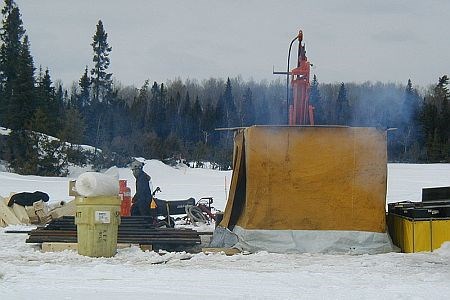The bones of a gold mine that never was are on the verge of being brought to life by Toronto-based junior firm Trelawney Mining and Exploration Inc.
Located 121 kilometres southwest of Timmins, or 162 kilometres northwest of Sudbury, the Chester Property’s existing underground workings and big-name board appointments will allow for production sooner rather than later.
“We have a nice little property that’s going to make a nice little mine, with potential to grow,” says Trelawney president Greg Gibson, who has 30 years of experience in narrow-vein mining.
“We couldn’t really be sitting at a better time right now.”
The property was explored and developed by Chesbar Resources and Murgold Resources in the late 1980s, though the two stopped short of production due to a drop-off in gold prices and a lack of a mill. The property traded hands until Trelawney optioned it in late August 2009, followed by an acquisition of the adjacent Young-Shannon property from Metallum Resources.
The work done to the property nearly 20 years ago would cost roughly $20 million at today’s prices, says Gibson. It includes a 550-foot decline reaching to the 500-foot level, a shaft on the east end of the gold vein and more than 2,300 feet of drifting on three levels.
This will allow the company to spend $1.8 million to get to the production stage within six months, generating 250 tons per day. By spending another $3.5 million, production could be increased to 600 tons per day within 16 months.
Trelawney is waiting on regulatory approvals before starting to move, but Gibson says work can begin rapidly once they’re in hand. The mine will be dewatered over 30 days while the ventilation system would be installed. Once that work is done, the ore can be accessed for a 30,000-ton bulk sample and advanced exploration in the first quarter of 2010, dependent on ground support and other related studies.
Although no industry-accepted resource is in place, historical drilling indicates roughly 142,217 tons grading 14.5 grams was accessible from current workings. If accurate, it would allow for two years of production, though additional exploration on Chester and the nearby Young-Shannon, which can be explored from Chester’s ramp, could add to that number.
To start firming up its figures, Trelawney has begun to use some of the $2.9 million raised in late August to begin a 1,700-metre drill program. This will test known gold-bearing structures to the 300-metre level, more than 100 metres beyond where the majority of prior exploration had taken place.
While the lack of a mill posed a big roadblock for the original developers of the Chester Property, Trelawney will overcome the problem by milling at Lake Shore Gold Corp.’s Bell Creek facility. That relationship has solidified in other ways, including the appointment of Lake Shore’s president and CEO Tony Makuch to the Trelawney board of directors.
“He’s pretty switched on and adds an awful lot to the company,” says Gibson.
The connections to Lake Shore don’t end there. Trelawney added exploration manager David Beilhartz, who most recently served as the vice-president of exploration for Lake Shore.
Once production begins, between 50 and 70 other employees will also be brought onboard.
Partnerships are also being developed with the Mattagami First Nation, whose traditional lands include Trelawney’s Chester and Young-Shannon properties.
www.trelawneymining.com




